warning light PORSCHE 911 TURBO 2014 6.G Manual PDF
[x] Cancel search | Manufacturer: PORSCHE, Model Year: 2014, Model line: 911 TURBO, Model: PORSCHE 911 TURBO 2014 6.GPages: 300, PDF Size: 10.61 MB
Page 224 of 300

222 Maintenance and Car Care
Checking Engine Oil Level
fCheck the oil level on the multi-function display at regular intervals before refueling.fPlease see the chapter “DISPLAY AND MEASUREMENT OF THE ENGINE OIL LEVEL” on page 101.
Engine oil is hazardous to your health and may be fatal if swallowed.fKeep engine oil out of children's reach.
Used engine oil contains chemicals that have caused cancer in laboratory animals.fAlways protect your skin by washing thoroughly with soap and water.
If you suspect an oil leak in the engine have your authorized Porsche dealer check it out immediately.
Top-up quantity
The difference between the minimum and maximum marks on the segment display is approx. 1.8 quarts (1.7 liters).fNever add more engine oil than required to reach the maximum mark.
If the oil level is too low, this is indicated by the oil-warning light on the multi-function display.fAdd engine oil immediately.fPlease see the chapter “OVERVIEW OF WARNING AND INFORMATION MESSAGES” on page 129.
Measuring the oil level after topping up engine oil or opening the engine compartment lid
The oil level can be checked after waiting for approx. 1 minute with the vehicle parked on a level surface and the engine at operating temperature.
If the engine compartment lid (Cabriolet convertible-top compartment lid) is opened when the engine is cold (e.g. in order to top up engine oil), the oil level cannot be displayed for a certain time.The message “ No information about oil level available at present ” appears on the multi-function display.fEngine oil should therefore only be topped up with the engine at operating temperature. This ensures short waiting times for the soonest possible oil level display.
Hands, fingers, items of clothing (ties, sleeves, etc.), necklaces or long hair can be drawn in by moving parts, e.g. the engine-compartment blowers, drive belt, etc., when working in the engine compartment.
The engine-compartment blowers are mounted under the engine compartment lid.After the engine is switched off, the engine compartment temperature is monitored for approx. 30 minutes.During this period, and depending on temperature, the engine-compartment blowers may continue to run or start to run.fCarry out work in this area only with the engine off and exercise extreme caution.
Risk of burns from hot parts in the engine compartment.fExercise extreme caution when working in the engine compartment.fPlease see the chapter “MEASUREMENTS ON TEST STANDS” on page 221.
Information
The “Check Engine” warning light may come on if the cap of the oil filler opening is opened while the engine is running.
Topping Up Engine Oil
Porsche recommends .
The right oil for your vehicle:
1) Generally, you can find details on the manufacturer approvals on the oil containers or as a notice displayed by the retailer.The current approval status is also available from your authorized Porsche dealer.2) SAE viscosity class – Example: SAE 0W - 40 Specification 0W = Viscosity specification for low temperatures (winter).Specification 40 = Viscosity specification for high temperatures.3) For all temperature ranges.4) For the temperature range above –13 °F(–25 °C).
Swallowing Engine Oil
Engine Oil Cancer Risk
Oil-level warning
DANGERh
WARNINGh
Engine-compartment blowers or other moving parts in the area of the engine
WARNINGh
Hot Engine Parts
Complies with approval1)Viscosity class2)
Porsche A40 SAE 0W - 403)
SAE 5W - 404)
SAE 5W - 504)
WARNINGh
14_991_Turbo_21.book Seite 222 Mittwoch, 9. April 2014 2:19 14
Page 226 of 300
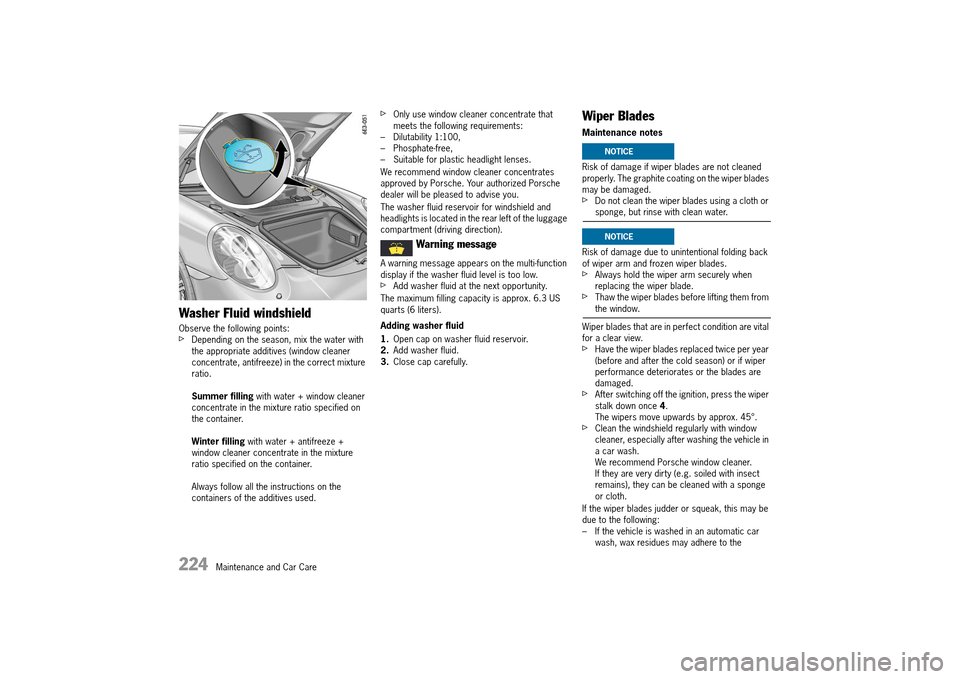
224 Maintenance and Car Care
Washer Fluid windshield
Observe the following points:fDepending on the season, mix the water with the appropriate additives (window cleaner concentrate, antifreeze) in the correct mixture ratio.
Summer filling with water + window cleaner concentrate in the mixture ratio specified on the container.
Winter filling with water + antifreeze + window cleaner concentrate in the mixture ratio specified on the container.
Always follow all the instructions on the containers of the additives used.
fOnly use window cleaner concentrate that meets the following requirements:– Dilutability 1:100,– Phosphate-free,– Suitable for plastic headlight lenses.
We recommend window cleaner concentrates approved by Porsche. Your authorized Porsche dealer will be pleased to advise you.
The washer fluid reservoir for windshield and headlights is located in the rear left of the luggage compartment (driving direction).
A warning message appears on the multi-function display if the washer fluid level is too low.fAdd washer fluid at the next opportunity.
The maximum filling capacity is approx. 6.3 US quarts (6 liters).
Adding washer fluid
1. Open cap on washer fluid reservoir. 2. Add washer fluid. 3. Close cap carefully.
Wiper Blades
Maintenance notes
Risk of damage if wiper blades are not cleaned properly. The graphite coating on the wiper blades may be damaged.fDo not clean the wiper blades using a cloth or sponge, but rinse with clean water.
Risk of damage due to unintentional folding back of wiper arm and frozen wiper blades.fAlways hold the wiper arm securely when replacing the wiper blade.fThaw the wiper blades before lifting them from the window.
Wiper blades that are in perfect condition are vital for a clear view.fHave the wiper blades replaced twice per year (before and after the cold season) or if wiper performance deteriorates or the blades are damaged.fAfter switching off the ignition, press the wiper stalk down once 4. The wipers move upwards by approx. 45°.fClean the windshield regularly with window cleaner, especially after washing the vehicle in a car wash.We recommend Porsche window cleaner. If they are very dirty (e.g. soiled with insect remains), they can be cleaned with a sponge or cloth.
If the wiper blades judder or squeak, this may be due to the following:– If the vehicle is washed in an automatic car wash, wax residues may adhere to the
Warning message
NOTICE
NOTICE
14_991_Turbo_21.book Seite 224 Mittwoch, 9. April 2014 2:19 14
Page 229 of 300

Maintenance and Car Care 227
fAlways monitor your fuel consumption.fDrive smoothly, avoid abrupt changes in speed as much as possible.fAvoid jack rabbit starts and sudden stops.fDo not drive longer than necessary in the lower gears. Shifting into a higher gear early without lugging the engine will help save fuel.fProlonged “warm up” idling wastes gas. Start the vehicle just before you are ready to drive. Accelerate slowly and smoothly.fSwitch off the engine if stationary for longer periods.fAny additional weight carried in the vehicle reduces fuel economy. Always keep cargo to a minimum and remove all unnecessary items.fOrganize your trips to take in several errands in one trip.fAll electrical accessories contribute to increased fuel consumption.fOnly switch on the air conditioning when necessary.fDo not drive with the Roof Transport System mounted unless you need it.
The EPA estimated miles per gallon (mpg) is to be used for comparison purposes, actual mileage may be different from the estimated mpg, depending on your driving speed, weather conditions and trip length. Your actual highway mileage may be less than the estimated mpg.fPlease observe all local and national speed limits.
Operating Your Porsche in other
Countries
Government regulations in the United States and Canada require that automobiles meet specific emission regulations and safety standards. Therefore, cars built for the U.S. and Canada differ from vehicles sold in other countries.
If you plan to take your Porsche outside the continental limits of the United States or Canada, there is the possibility that:– Unleaded fuel may not be available,– Unleaded fuel may have a considerably lower octane rating. Excessive engine knock and serious damage to both engine and catalytic converters could result,– Service may be inadequate due to lack of proper service facilities, tools or diagnostic equipment,– Replacement parts may not be available or very difficult to get.
Porsche cannot be responsible for the mechanical damage that could result because of inadequate fuel, service or parts availability.
If you purchased your Porsche abroad and want to bring it back home, be sure to find out about shipping and forwarding requirements, as well as current import and customs regulations.
Fuel
When the ignition is on, the fuel level is displayed on the instrument panel.fPlease see the chapter “FUEL GAUGE” on page 90.
fFire, open flame and smoking are prohibited when handling fuel.
Fuel and fuel vapors are hazardous to health.fAvoid contact with skin or clothing, since injury to your skin may occur.fDo not inhale fuel vapors, since they may make you ill and possibly cause death if inhalation is prolonged and occurs in a closed space.
To prevent damage to the emission control system and engine:fNever drive the tank dry.fAvoid high cornering speeds after the warning lights have come on.
fPlease see the chapter “FUEL ECONOMY” on page 226.
Check engine warning light
If the warning lights in the instrument panel come on and remain on while driving, it suggests: – a potential engine control problem and the need for system service or – an improperly fastened tank cap or
refueling with engine running.
Refueling Fire Risk
Fuel Vapors and Skin Contact
DANGERh
WARNINGh
NOTICE
14_991_Turbo_21.book Seite 227 Mittwoch, 9. April 2014 2:19 14
Page 234 of 300
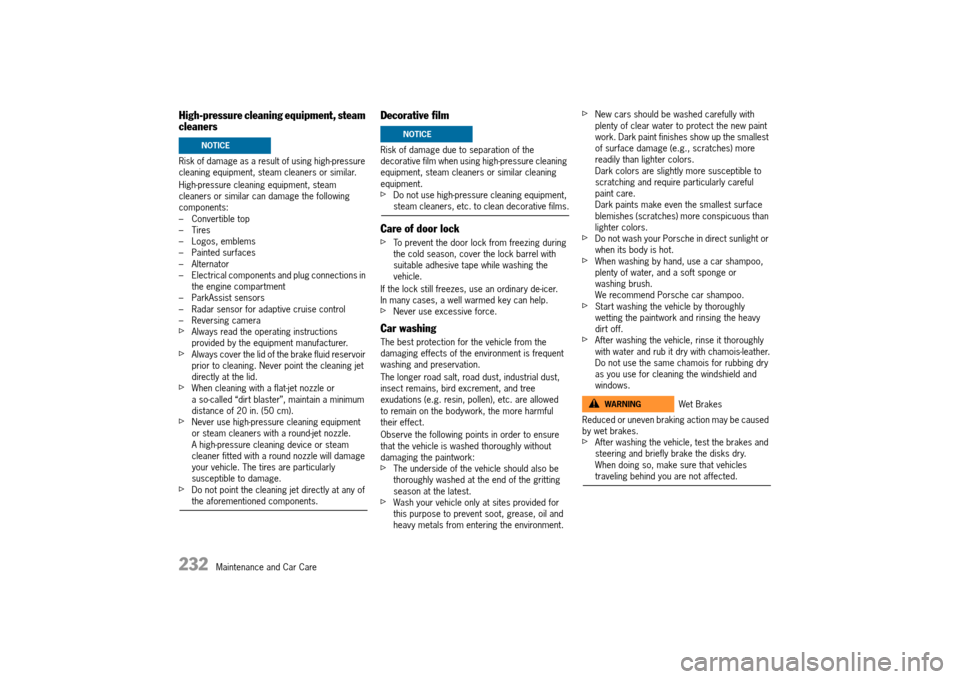
232 Maintenance and Car Care
High-pressure cleaning equipment, steam cleaners
Risk of damage as a result of using high-pressure cleaning equipment, steam cleaners or similar.
High-pressure cleaning equipment, steam cleaners or similar can damage the following components:– Convertible top– Tires– Logos, emblems– Painted surfaces– Alternator– Electrical components and plug connections in the engine compartment– ParkAssist sensors– Radar sensor for adaptive cruise control– Reversing camerafAlways read the operating instructions provided by the equipment manufacturer.fAlways cover the lid of the brake fluid reservoir prior to cleaning. Never point the cleaning jet directly at the lid.fWhen cleaning with a flat-jet nozzle or a so-called “dirt blaster”, maintain a minimum distance of 20 in. (50 cm).fNever use high-pressure cleaning equipment or steam cleaners with a round-jet nozzle.A high-pressure cleaning device or steam cleaner fitted with a round nozzle will damage your vehicle. The tires are particularly susceptible to damage.fDo not point the cleaning jet directly at any of the aforementioned components.
Decorative film
Risk of damage due to separation of the decorative film when using high-pressure cleaning equipment, steam cleaners or similar cleaning equipment.fDo not use high-pressure cleaning equipment, steam cleaners, etc. to clean decorative films.
Care of door lock
fTo prevent the door lock from freezing during the cold season, cover the lock barrel with suitable adhesive tape while washing the vehicle.
If the lock still freezes, use an ordinary de-icer. In many cases, a well warmed key can help.fNever use excessive force.
Car washing
The best protection for the vehicle from the damaging effects of the environment is frequent washing and preservation.
The longer road salt, road dust, industrial dust, insect remains, bird excrement, and tree exudations (e.g. resin, pollen), etc. are allowed to remain on the bodywork, the more harmful their effect.
Observe the following points in order to ensure that the vehicle is washed thoroughly without damaging the paintwork: fThe underside of the vehicle should also be thoroughly washed at the end of the gritting season at the latest.fWash your vehicle only at sites provided for this purpose to prevent soot, grease, oil and heavy metals from entering the environment.
fNew cars should be washed carefully with plenty of clear water to protect the new paint work. Dark paint finishes show up the smallest of surface damage (e.g., scratches) more readily than lighter colors. Dark colors are slightly more susceptible to scratching and require particularly careful paint care.Dark paints make even the smallest surface blemishes (scratches) more conspicuous than lighter colors.fDo not wash your Porsche in direct sunlight or when its body is hot.fWhen washing by hand, use a car shampoo, plenty of water, and a soft sponge or washing brush.We recommend Porsche car shampoo.fStart washing the vehicle by thoroughly wetting the paintwork and rinsing the heavy dirt off.fAfter washing the vehicle, rinse it thoroughly with water and rub it dry with chamois-leather.Do not use the same chamois for rubbing dry as you use for cleaning the windshield and windows.
Reduced or uneven braking action may be caused by wet brakes.fAfter washing the vehicle, test the brakes and steering and briefly brake the disks dry.When doing so, make sure that vehicles traveling behind you are not affected.
NOTICENOTICE
Wet BrakesWARNINGh
14_991_Turbo_21.book Seite 232 Mittwoch, 9. April 2014 2:19 14
Page 237 of 300
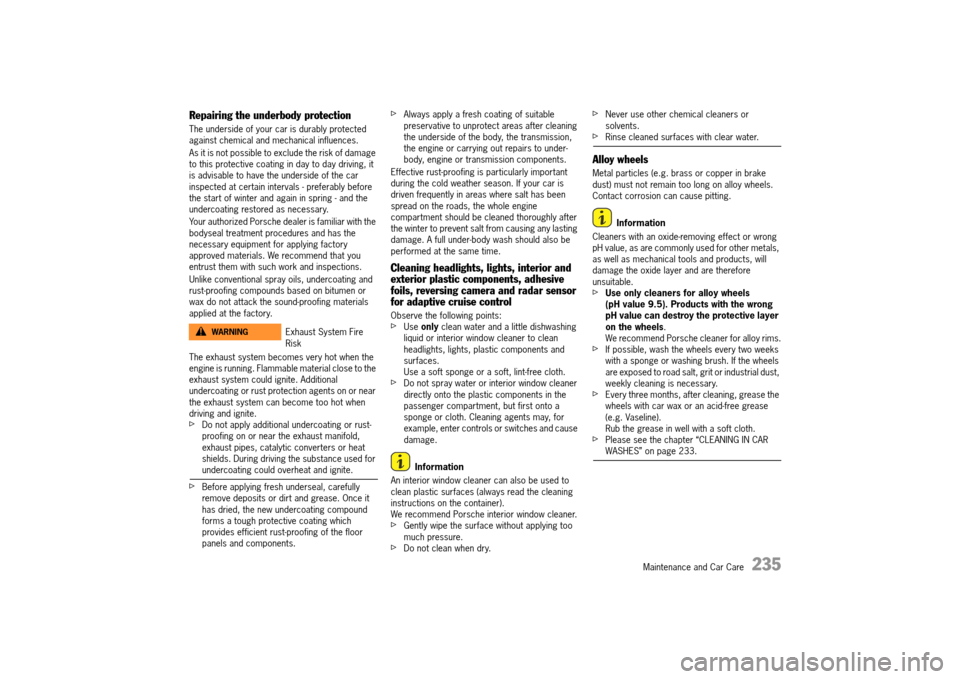
Maintenance and Car Care 235
Repairing the underbody protection
The underside of your car is durably protected against chemical and mechanical influences.
As it is not possible to exclude the risk of damage to this protective coating in day to day driving, it is advisable to have the underside of the car inspected at certain intervals - preferably before the start of winter and again in spring - and the undercoating restored as necessary.
Your authorized Porsche dealer is familiar with the bodyseal treatment procedures and has the necessary equipment for applying factory approved materials. We recommend that you entrust them with such work and inspections.
Unlike conventional spray oils, undercoating and rust-proofing compounds based on bitumen or wax do not attack the sound-proofing materials applied at the factory.
The exhaust system becomes very hot when the engine is running. Flammable material close to the exhaust system could ignite. Additional undercoating or rust protection agents on or near the exhaust system can become too hot when driving and ignite.fDo not apply additional undercoating or rust-proofing on or near the exhaust manifold, exhaust pipes, catalytic converters or heat shields. During driving the substance used for undercoating could overheat and ignite.
fBefore applying fresh underseal, carefully remove deposits or dirt and grease. Once it has dried, the new undercoating compound forms a tough protective coating which provides efficient rust-proofing of the floor panels and components.
fAlways apply a fresh coating of suitable preservative to unprotect areas after cleaning the underside of the body, the transmission, the engine or carrying out repairs to under-body, engine or transmission components.
Effective rust-proofing is particularly important during the cold weather season. If your car is driven frequently in areas where salt has been spread on the roads, the whole engine compartment should be cleaned thoroughly after the winter to prevent salt from causing any lasting damage. A full under-body wash should also be performed at the same time.
Cleaning headlights, lights, interior and exterior plastic components, adhesive foils, reversing camera and radar sensor for adaptive cruise control
Observe the following points: fUse only clean water and a little dishwashing liquid or interior window cleaner to clean headlights, lights, plastic components and surfaces.Use a soft sponge or a soft, lint-free cloth.fDo not spray water or interior window cleaner directly onto the plastic components in the passenger compartment, but first onto a sponge or cloth. Cleaning agents may, for example, enter controls or switches and cause damage.
Information
An interior window cleaner can also be used to clean plastic surfaces (always read the cleaning instructions on the container).We recommend Porsche interior window cleaner.fGently wipe the surface without applying too much pressure.fDo not clean when dry.
fNever use other chemical cleaners or solvents.fRinse cleaned surfaces with clear water.
Alloy wheels
Metal particles (e.g. brass or copper in brake dust) must not remain too long on alloy wheels.Contact corrosion can cause pitting.
Information
Cleaners with an oxide-removing effect or wrong pH value, as are commonly used for other metals, as well as mechanical tools and products, will damage the oxide layer and are therefore unsuitable.fUse only cleaners for alloy wheels (pH value 9.5). Products with the wrong pH value can destroy the protective layer on the wheels . We recommend Porsche cleaner for alloy rims.fIf possible, wash the wheels every two weeks with a sponge or washing brush. If the wheels are exposed to road salt, grit or industrial dust, weekly cleaning is necessary.fEvery three months, after cleaning, grease the wheels with car wax or an acid-free grease (e.g. Vaseline).Rub the grease in well with a soft cloth.fPlease see the chapter “CLEANING IN CAR WASHES” on page 233.
Exhaust System Fire Risk
WARNINGh
14_991_Turbo_21.book Seite 235 Mittwoch, 9. April 2014 2:19 14
Page 238 of 300
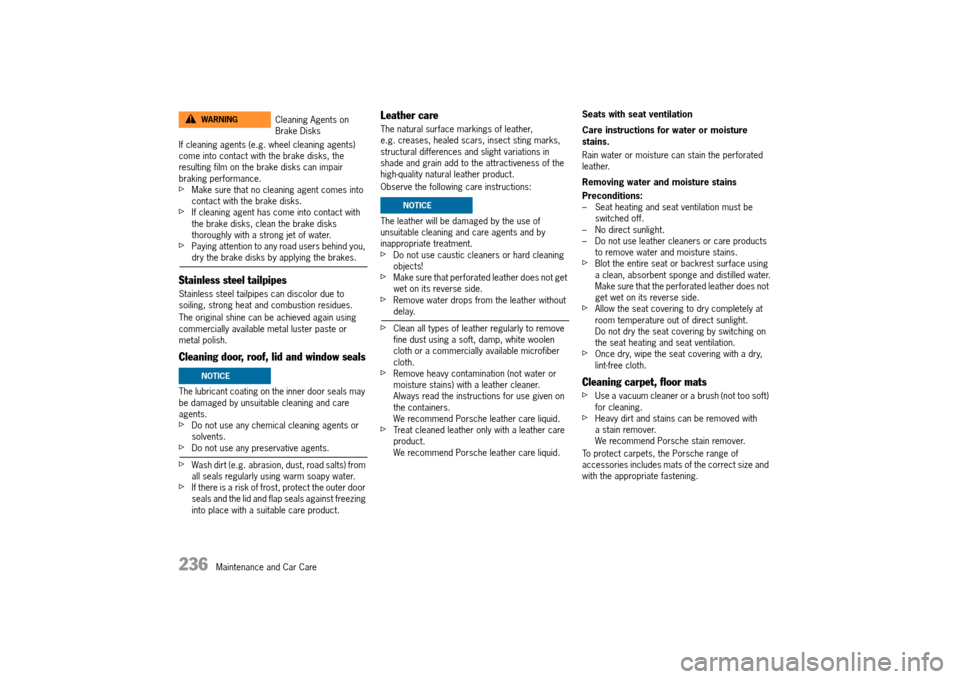
236 Maintenance and Car Care
If cleaning agents (e.g. wheel cleaning agents) come into contact with the brake disks, the resulting film on the brake disks can impair braking performance.fMake sure that no cleaning agent comes into contact with the brake disks.fIf cleaning agent has come into contact with the brake disks, clean the brake disks thoroughly with a strong jet of water.fPaying attention to any road users behind you, dry the brake disks by applying the brakes.
Stainless steel tailpipes
Stainless steel tailpipes can discolor due to soiling, strong heat and combustion residues.
The original shine can be achieved again using commercially available metal luster paste or metal polish.
Cleaning door, roof, lid and window seals
The lubricant coating on the inner door seals may be damaged by unsuitable cleaning and care agents.fDo not use any chemical cleaning agents or solvents.fDo not use any preservative agents.
fWash dirt (e.g. abrasion, dust, road salts) from all seals regularly using warm soapy water.fIf there is a risk of frost, protect the outer door seals and the lid and flap seals against freezing into place with a suitable care product.
Leather care
The natural surface markings of leather, e.g. creases, healed scars, insect sting marks, structural differences and slight variations in shade and grain add to the attractiveness of the high-quality natural leather product.
Observe the following care instructions:
The leather will be damaged by the use of unsuitable cleaning and care agents and by inappropriate treatment.fDo not use caustic cleaners or hard cleaning objects!fMake sure that perforated leather does not get wet on its reverse side.fRemove water drops from the leather without delay.
fClean all types of leather regularly to remove fine dust using a soft, damp, white woolen cloth or a commercially available microfiber cloth.fRemove heavy contamination (not water or moisture stains) with a leather cleaner.Always read the instructions for use given on the containers.We recommend Porsche leather care liquid.fTreat cleaned leather only with a leather care product.We recommend Porsche leather care liquid.
Seats with seat ventilation
Care instructions for water or moisture stains.
Rain water or moisture can stain the perforated leather.
Removing water and moisture stains
Preconditions: – Seat heating and seat ventilation must be switched off.– No direct sunlight.– Do not use leather cleaners or care products to remove water and moisture stains.fBlot the entire seat or backrest surface using a clean, absorbent sponge and distilled water.Make sure that the perforated leather does not get wet on its reverse side.fAllow the seat covering to dry completely at room temperature out of direct sunlight.Do not dry the seat covering by switching on the seat heating and seat ventilation.fOnce dry, wipe the seat covering with a dry, lint-free cloth.
Cleaning carpet, floor mats
fUse a vacuum cleaner or a brush (not too soft) for cleaning.fHeavy dirt and stains can be removed with a stain remover.We recommend Porsche stain remover.
To protect carpets, the Porsche range of accessories includes mats of the correct size and with the appropriate fastening.
Cleaning Agents on Brake Disks
WARNINGh
NOTICE
NOTICE
14_991_Turbo_21.book Seite 236 Mittwoch, 9. April 2014 2:19 14
Page 239 of 300
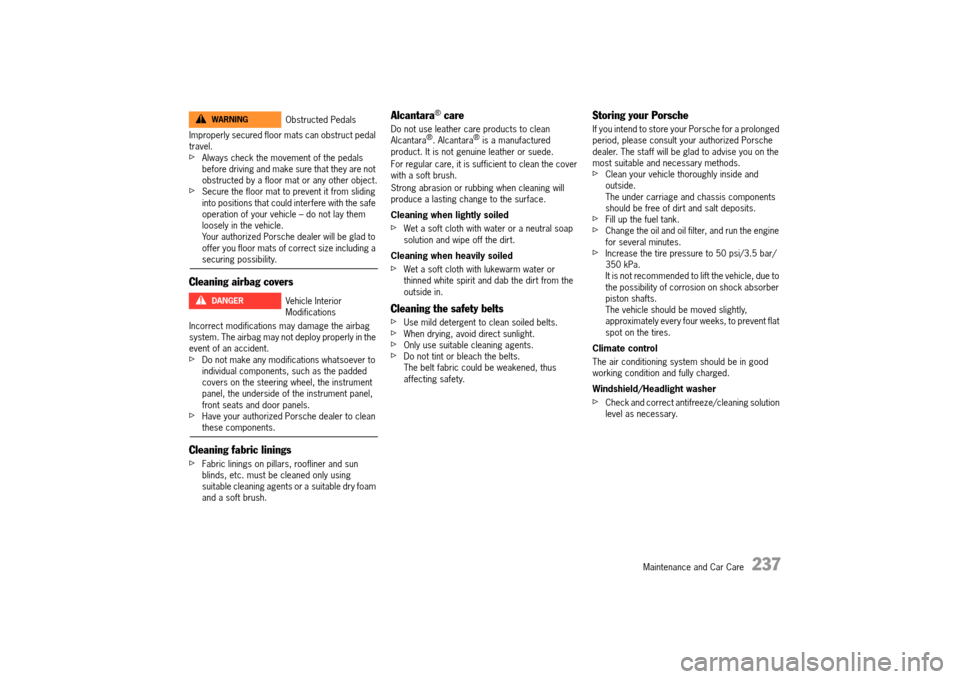
Maintenance and Car Care 237
Improperly secured floor mats can obstruct pedal travel.fAlways check the movement of the pedals before driving and make sure that they are not obstructed by a floor mat or any other object.fSecure the floor mat to prevent it from sliding into positions that could interfere with the safe operation of your vehicle – do not lay them loosely in the vehicle.Your authorized Porsche dealer will be glad to offer you floor mats of correct size including a securing possibility.
Cleaning airbag covers
Incorrect modifications may damage the airbag system. The airbag may not deploy properly in the event of an accident.fDo not make any modifications whatsoever to individual components, such as the padded covers on the steering wheel, the instrument panel, the underside of the instrument panel, front seats and door panels.fHave your authorized Porsche dealer to clean these components.
Cleaning fabric linings
fFabric linings on pillars, roofliner and sun blinds, etc. must be cleaned only using suitable cleaning agents or a suitable dry foam and a soft brush.
Alcantara® care
Do not use leather care products to clean Alcantara®. Alcantara® is a manufactured product. It is not genuine leather or suede.
For regular care, it is sufficient to clean the cover with a soft brush.
Strong abrasion or rubbing when cleaning will produce a lasting change to the surface.
Cleaning when lightly soiled
fWet a soft cloth with water or a neutral soap solution and wipe off the dirt.
Cleaning when heavily soiled
fWet a soft cloth with lukewarm water or thinned white spirit and dab the dirt from the outside in.
Cleaning the safety belts
fUse mild detergent to clean soiled belts.fWhen drying, avoid direct sunlight.fOnly use suitable cleaning agents.fDo not tint or bleach the belts.The belt fabric could be weakened, thus affecting safety.
Storing your Porsche
If you intend to store your Porsche for a prolonged period, please consult your authorized Porsche dealer. The staff will be glad to advise you on the most suitable and necessary methods. fClean your vehicle thoroughly inside and outside. The under carriage and chassis components should be free of dirt and salt deposits. fFill up the fuel tank. fChange the oil and oil filter, and run the engine for several minutes. fIncrease the tire pressure to 50 psi/3.5 bar/350 kPa.It is not recommended to lift the vehicle, due to the possibility of corrosion on shock absorber piston shafts.The vehicle should be moved slightly, approximately every four weeks, to prevent flat spot on the tires.
Climate control
The air conditioning system should be in good working condition and fully charged.
Windshield/Headlight washer
fCheck and correct antifreeze/cleaning solution level as necessary.
Obstructed Pedals
Vehicle Interior Modifications
WARNINGh
DANGERh
14_991_Turbo_21.book Seite 237 Mittwoch, 9. April 2014 2:19 14
Page 245 of 300
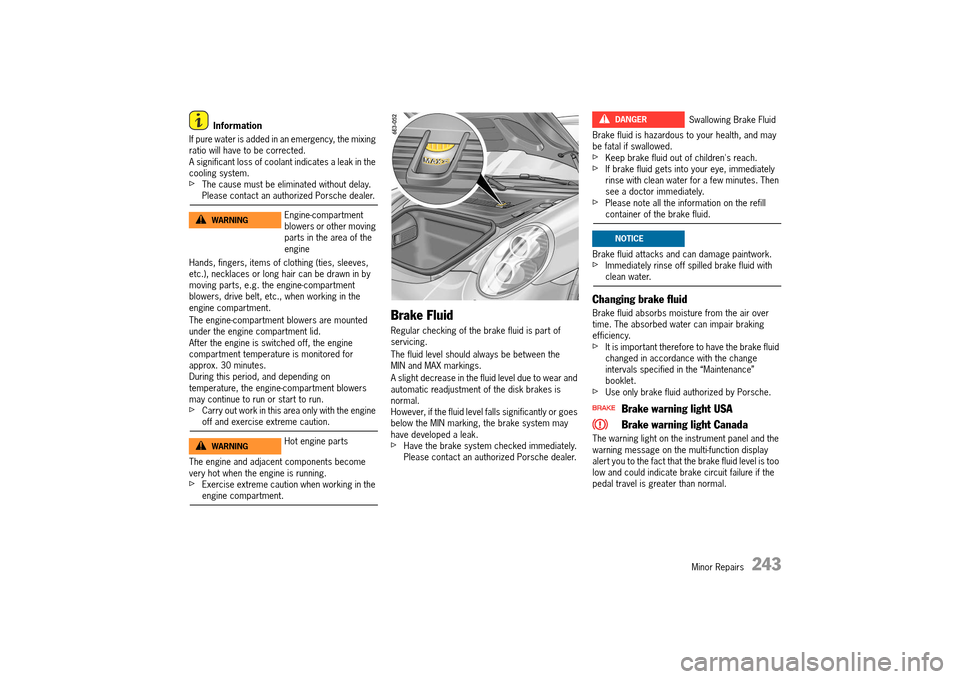
Minor Repairs 243
Information
If pure water is added in an emergency, the mixing ratio will have to be corrected.A significant loss of coolant indicates a leak in the cooling system.fThe cause must be eliminated without delay. Please contact an authorized Porsche dealer.
Hands, fingers, items of clothing (ties, sleeves, etc.), necklaces or long hair can be drawn in by moving parts, e.g. the engine-compartment blowers, drive belt, etc., when working in the engine compartment.
The engine-compartment blowers are mounted under the engine compartment lid.After the engine is switched off, the engine compartment temperature is monitored for approx. 30 minutes.During this period, and depending on temperature, the engine-compartment blowers may continue to run or start to run.fCarry out work in this area only with the engine off and exercise extreme caution.
The engine and adjacent components become very hot when the engine is running.fExercise extreme caution when working in the engine compartment.
Brake Fluid
Regular checking of the brake fluid is part of servicing.
The fluid level should always be between the MIN and MAX markings.
A slight decrease in the fluid level due to wear and automatic readjustment of the disk brakes is normal.However, if the fluid level falls significantly or goes below the MIN marking, the brake system may have developed a leak.fHave the brake system checked immediately. Please contact an authorized Porsche dealer.
Brake fluid is hazardous to your health, and may be fatal if swallowed.fKeep brake fluid out of children's reach.fIf brake fluid gets into your eye, immediately rinse with clean water for a few minutes. Then see a doctor immediately.fPlease note all the information on the refill container of the brake fluid.
Brake fluid attacks and can damage paintwork.fImmediately rinse off spilled brake fluid with clean water.
Changing brake fluid
Brake fluid absorbs moisture from the air over time. The absorbed water can impair braking efficiency.fIt is important therefore to have the brake fluid changed in accordance with the change intervals specified in the “Maintenance” booklet.fUse only brake fluid authorized by Porsche.
Brake warning light USA
Brake warning light Canada
The warning light on the instrument panel and the warning message on the multi-function display alert you to the fact that the brake fluid level is too low and could indicate brake circuit failure if the pedal travel is greater than normal.
Engine-compartment blowers or other moving parts in the area of the engine
Hot engine parts
WARNINGh
WARNINGh
Swallowing Brake FluidDANGERh
NOTICE
14_991_Turbo_21.book Seite 243 Mittwoch, 9. April 2014 2:19 14
Page 246 of 300

244 Minor Repairs
Information
If the warning light and warning message appear when driving: fStop immediately in a suitable place.fDo not continue driving.Please contact an authorized Porsche dealer.
For information on warning messages on the multi- function display: fPlease see the chapter “OVERVIEW OF WARNING AND INFORMATION MESSAGES” on page 129.
Electromechanical Power Steering
When the engine is stopped (e.g. when on tow), no power steering assistance is available.Increased force is required for steering.fExercise extreme care when your vehicle is being towed.fHave the fault corrected. Please contact an authorized Porsche dealer.
Changing Air Cleaner
Regular replacement of the filter element is part of servicing.fIn dusty conditions, clean the filter element more frequently and replace it if necessary.fPlease see the chapter “MEASUREMENTS ON TEST STANDS” on page 241.
Changing Particle Filters
Regular replacement of the filters is part of servicing.
Dirty filters can be the cause of reduced air throughput, e.g. the windows can mist up.fHave the filters replaced.Please contact an authorized Porsche dealer.
Information
The particle filters ensure that the fresh air entering the passenger compartment is virtually free of dust and pollen.fIf the outside air is polluted by exhaust fumes, press the recirculated-air button.
Tires and Wheels
The original equipment tires and wheel rims on your Porsche comply with all applicable Federal Motor Vehicle Safety Standards.
Information
The summer tires of your Sports Car have been specially developed and adapted for high performance.The tire characteristics change at low outside temperatures (below 15 °C).This can result in noises when parking or maneuvering at low outside temperatures.
For your safety remember the following:
– Wheel rims and wheel bolts are matched to fit your Porsche.– If you intend to use other than original equipment wheels, be sure that they conform to Porsche specifications for your model. Only tires with the same make and with the same specification code (e.g. “N0”, “N1”...) can be mounted.– The use of wheel rims and wheel bolts that do not meet specifications of the original factory installed equipment will affect the safe operation of your vehicle and affect warranty coverage.– Before you plan on exchanging wheels, or snow tires already mounted on the wheel rims, consult your authorized Porsche dealer. Your dealer has the technical information necessary to advise you which wheel rims and wheel bolts are compatible with the original factory installations.
No Power Steering AssistWARNINGh
14_991_Turbo_21.book Seite 244 Mittwoch, 9. April 2014 2:19 14
Page 248 of 300

246 Minor Repairs
The temperature grade for this tire is established for a tire that is properly inflated and not overloaded. Excessive speed, underinflation, or excessive loading, either separately or in combination, can cause heat buildup and possible tire failure.fDo not exceed the permitted maximum speed for the tires fitted to the vehicle.fEnsure that the tires are set to the correct inflation pressure.fObserve the maximum load for the vehicle.
Tire pressures
Driving the vehicle with low tire pressure increases risk of a tire failure and resulting loss of control. Furthermore, low tire pressure increases rate of wear of the affected tires and causes damage. fAlways use an accurate tire pressure gauge when checking inflation pressures.fDo not exceed the maximum tire pressure listed on the tire sidewall. (Also refer to “Technical data”).fPlease see the chapter “TIRE PRESSURE PLATE” on page 247.fCold tire inflation pressure means: all tires must be cold, ambient temperature maximum 68 °F (20 °C), when adjusting the inflation pressure. Avoid sunlight striking the tires before measuring cold pressures, since the pressures would rise from temperature influence.fValve caps protect the valve from dust and dirt, and thus from leakage. Always screw caps tightly down. Replace missing caps immediately.
fUse only plastic valve caps.fFor safety reasons, don't use tire inflating bottles.
fPlease see the chapter “TIRE PRESSURE FOR COLD TIRES (68 °F/ 20 °C)” on page 287.
Each tire, including the spare (if provided), should be checked monthly when cold and inflated to the
inflation pressure recommended by the vehicle manufacturer on the vehicle placard or tire inflation pressure label. (If your vehicle has tires of
a different size than the size indicated on the vehicle placard or tire inflation pressure label, you
should determine the proper tire inflation pressure
for those tires.)
As an added safety feature, your vehicle has been equipped with a Tire Pressure Monitoring System (TPMS) that illuminates a low tire pressure telltale when one or more of your tires is significantly under-inflated. Accordingly, when the low tire pressure telltale illuminates, you should stop and check your tires as soon as possible, and inflate them to the proper pressure. Driving on a significantly under-inflated tire causes the tire to overheat and can lead to tire failure. Under-inflation also reduces fuel efficiency and tire tread life, and may affect the vehicle’s handling and stopping ability.
Please note that the TPMS is not a substitute for proper tire maintenance, and it is the driver’s responsibility to maintain correct tire pressure, even if under-inflation has not reached the level to trigger illumination of the TPMS low tire pressure tell-tale.
For further information on the tire pressure monitoring:fPlease see the chapter “TIRE PRESSURE MENU (TIRE PRESSURE MONITORING SYSTEM, TPMS)” on page 105.
When tires are warm, the tire pressure is increased.fNever let air out of hot tires. This could cause the tire pressure to fall below the prescribed value.
Insufficient tire pressure can cause tires to over- heat and thus be damaged – even invisibly. Hidden tire damage is not eliminated by subsequently correcting the tire pressure.
Overloading
Overloading can lead to dangerous vehicle reactions and long braking distances.fDo not overload your vehicle. Be careful about the roof load. fIf you plan to load the vehicle, first correct the tire pressure. Tire pressure for loaded vehicle can be found on the tire pressure plate and in the chapter technical data.fNever exceed the specified axle load.
Tire Abuse
Low Tire Pressure
WARNINGh
DANGERhOverloading TiresDANGERh
14_991_Turbo_21.book Seite 246 Mittwoch, 9. April 2014 2:19 14